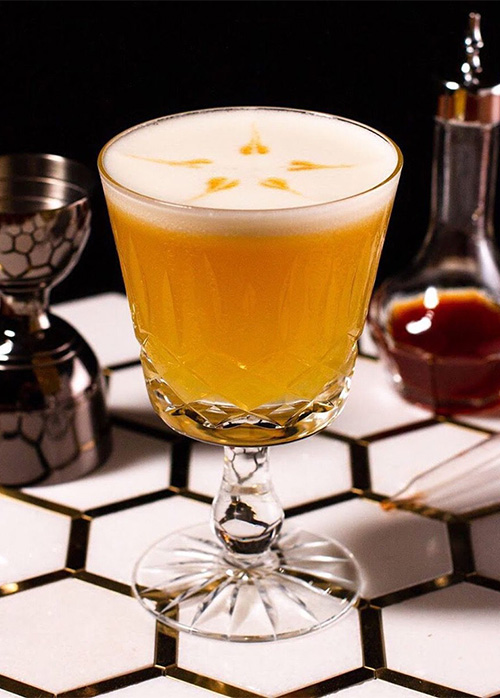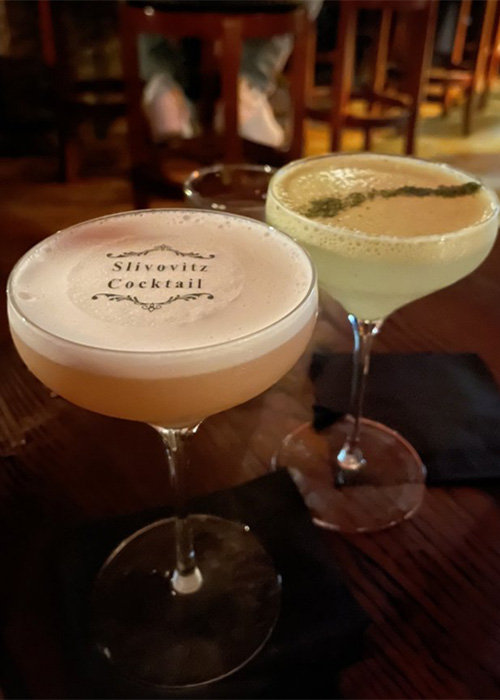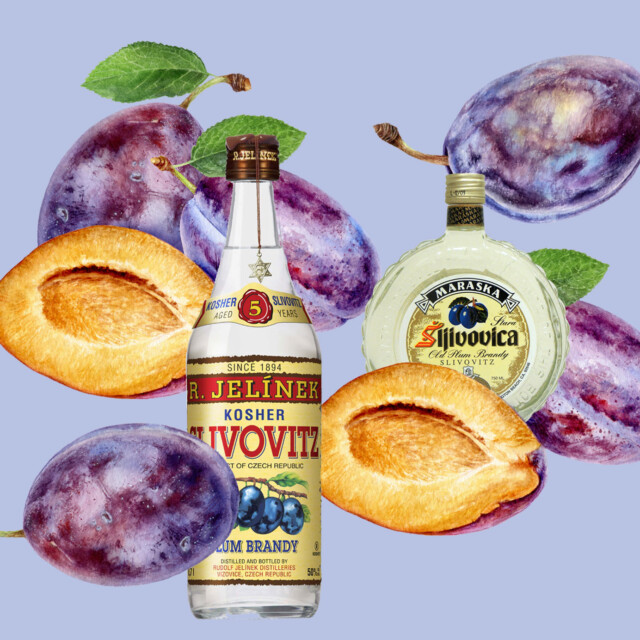When life hands you lemons, make lemonade. But what do you do when life sends you plums?
If you’re at Rose Mary, “Top Chef” winner Joe Flamm’s debut restaurant in Chicago’s West Loop, the answer is obvious: roast them, infuse them in vodka, add a pinch of sugar to play on their inherent sweetness, age that mixture for most of a year, and then offer the resulting spirit in the form of a chilled shot as your after-meal take on slivovitz, the clear, plum-based distillate beloved across Central and Eastern Europe. With Rose Mary’s Croatian-Italian focus, that house-made infusion fits perfectly alongside imported bottles of slivovitz and plenty of customers who love it. But according to the restaurant’s beverage director, Kyle Davidson, that might be a very different story somewhere else.
“I would say, in general, slivovitz is not very well known,” he says. “We definitely feature it on every menu and have a variety available, and a lot of the clientele that comes in are familiar with it. But for the most part I would say it’s pretty under the radar.”
That feels like a missed opportunity, since plum-based slivovitz and related distillates made from apricots, pears, and peaches all have a lot to offer. They usually have great origin stories, frequently expressing a palpable sense of place, like Croatia’s six fruit distillates with Protected Geographical Indication (P.G.I.) status. Slivovitz itself can be intensely charismatic, rife with rich fruit and spice notes, the kind of thing that practically begs to be used in mixed drinks, though in their home regions, these drinks are most often sipped neat. So why haven’t slivovitz and other fruit spirits found the same popularity as tequila or bourbon?
A Taste of Eastern Europe
To start, it might be that such spirits simply have too much character. Dushan Zaric, co-founder of New York’s Employees Only, has written that slivovitz can “overtake” almost anything it’s blended with, comparing it to a bull in a china shop.
“Despite being a clear spirit, it’s not neutral at all,” Davidson says. “It wants to punch through. It wants to carry through in a cocktail.”
And then there’s the geography, since slivovitz is primarily associated with Eastern Europe, a region that is arguably harder to travel to and ship bottles from than France or Italy, to say nothing of our neighboring nation to the south.
“I feel like it’s kind of a geographic issue, where if you live in the United States you’ve probably been to Mexico, and/or been to a Mexican restaurant at some point,” he says.
A lack of a universally recognized cocktail also isn’t doing slivovitz any favors.
“The Margarita is just such a vehicle for tequila — it’s just one of the most popular cocktails that gets ordered across any bar program, if not the most popular cocktail,” Davidson says. “Slivovitz probably needs a signature cocktail. I think if there was something that could somehow become as popular as the Margarita, that would certainly help slivovitz become more popular.”
Depth and Complexity
In London’s cocktail world, fruit distillates in general are “mega trendy,” according to Alex Kratena, former head bartender at Artesian and the co-founder of both Tayēr + Elementary and Muyu liqueurs. But those fruit spirits are primarily coming from French and U.K. producers, often based on berries, and generally flying under the chic “eau de vie” moniker. The cool factor hasn’t yet been extended to plum-based slivovitz or other spirits from Central and Eastern Europe.
“A well-made slivovitz in a small quantity can bring the same complexity, but it can be overpowering in bigger quantities.”
“Here in the U.K., a lot of people are using raspberry and many other eaux de vie,” Kratena says. “Historically, there were a lot of French producers who were producing eaux de vie from everything. When they are well made, they are absolutely amazing for cocktails.”
No matter what you call it, the principle for working with a fruit distillate is the same, he says. To start, an eau de vie can greatly increase depth, especially when combined with other approaches, like a fruit fermentation or a fruit syrup.
“Those three things capture the flavor in a very particular way. But then, combined together, they give you amazing complexity,” he says. “A distillate can be an absolutely amazing way to capture the complexity of a fragrant fruit.”

That said, less is often more, he notes. Not every cocktail needs a full shot, and Kratena often uses them in much smaller amounts.
“We need to think very carefully about what it does, what flavor intensities it will bring,” he says. “Because a well-made slivovitz in a small quantity can bring the same complexity, but it can be overpowering in bigger quantities.”
A Balkan Rhum Agricole
While slivovitz is still waiting for its star cocktail, a few candidates have emerged, many of which echo the citrusy lines of the Sidecar or Pisco Sour. Rose Mary offers the Green Night, which mixes Croatia’s Maraska slivovitz with Midori, Chartreuse, and lime. In Arlington, Va., Baba bar and restaurant serves the Monastery, a blend of slivovitz, honey, lime, and plum preserves. Dushan Zaric himself came up with the Slivopolitan, which combines the plum distillate with Cointreau, lime, and plum puree. In Pittsburgh, the vegan bar and restaurant Apteka plays up its Central and Eastern European influences with its own slivovitz cocktails, often using brands from Serbia or Bosnia, sometimes incorporating sumac or other tart ingredients.
The author of “Barkeep — The Art of Mixology, Bar & Cocktails,” Danilo Bozovic first encountered slivovitz during his childhood in Serbia, where it ranks as the national spirit, a part of the broad category of fruit distillates known as rakija.
“I would say, as young as I can remember, it’s our tradition,” he says. “Everybody drinks it.”
For Bozovic, slivovitz is to the Balkans as rhum agricole is to the French-speaking parts of the Caribbean. Both can express a lot of funky notes from fermentation, as well as vegetal and grassy characteristics. And just like rhum agricole, when you describe slivovitz, some descriptors might scare off drinkers who haven’t tried it yet.
“It’s kind of like describing a certain type of cheese,” he says. “When you describe an agricole, it sometimes might be a bit off-putting, and you wouldn’t be so enticed by it. But then when you taste it, you’re like, ‘Wow. This actually works amazing.’”
“I haven’t found another component, in my humble opinion, and for my taste, that works better with slivovitz than absinthe. It opens up that ‘rhum agricole’ aroma that I mentioned — that earthiness, those very fruity, vegetal, and grassy notes.”
Although the drink is very popular in much of Eastern Europe, Bozovic ranks the stateside awareness of slivovitz somewhere between “non-existent” and “emerging.” Unlike many spirits, slivovitz doesn’t have big-shot brand ambassadors or celebrity mixologists promoting it, and Bozovic says he’s never heard of a maker of slivovitz or similar fruit distillates flying in journalists or bartenders on trips to show them how and where the drink is made.
“I don’t think that this spirit has the funds to back something like that,” he says. “There are big companies that make rakija, but I’m not quite sure why they’re not targeting the U.S. more aggressively.”
That means that promotion of slivovitz and similar spirits often comes down to individuals. For his venue in Miami, Swizzle Rum Bar and Drinkery, Bozovic created his own Slivovitz Cocktail, combining the plum spirit with wormwood-based génépi, lemon juice, egg white, and absinthe bitters.
A lack of consistency of stock from suppliers has meant that Bozovic has employed spirits from a number of different producers in the drink, though he currently name-checks Branko slivovitz from Serbia’s Belgrade Urban Distillery. The bitters, he says, play an important role.
“I haven’t found another component, in my humble opinion, and for my taste, that works better with slivovitz than absinthe. It opens up that ‘rhum agricole’ aroma that I mentioned — that earthiness, those very fruity, vegetal, and grassy notes, depending on the brand.”
Slivovitz might still be underground, but the Slivovitz Cocktail currently ranks as a top seller — at least at Bozovic’s bar.
“It works for me, but it works for a lot of people,” he says. “I believe that Swizzle Rum Bar and Drinkery is currently the biggest seller of slivovitz in Florida.”
Slivovitz Cocktail
By Danilo Bozovic

Ingredients
- 1¾ ounces slivovitz plum brandy
- ½ ounce plum wine
- ½ ounce Dolin Génépi des Alpes
- ¾ ounce lemon juice
- ¼ ounce simple syrup (1.5:1 sugar to water)
- 5 dashes of Angostura bitters
- 5 dashes of absinthe bitters*
- I raw egg white
Directions
- Dry shake all ingredients.
- Add large ice and shake vigorously.
- Strain into a chilled coupe glass.
- Garnish with a few drops of Angostura bitters.
*To make your own absinthe bitters, combine 3 cups Pernod absinthe, 1/2 cup Fernet Branca, 1 teaspoon Peychaud’s Bitters, and 2 tablespoons mint bitters.
